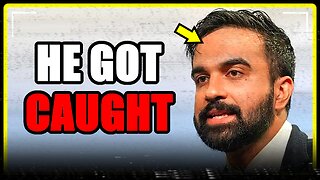Premium Only Content

Can You Get Shocked From a Neutral Conductor?
At some point, most of us electricians have received a shock from touching a hot conductor and something that is grounded. Some of us have also been shocked by touching 2 different hot conductors! But what about a neutral conductor? Is it possible to get shocked by the neutral? In the latest episode of Electrician U, Dustin talks about this phenomenon and clears a few things up.
🤘⚡️MEMBERSHIP⚡️🤘
JOIN ELECTRICIAN U - become a member and get:
FREE Continuing Education every year
FREE Practice Exams
FREE Monthly Video Courses
FREE Weekly Live Instructor-Led Classes
FREE Monthly Educational Newsletter
Premium Members-Only Content
Private Discord Channel
Monthly Members-Only Discord Chats
Sign up here --- https://www.electricianu.com/electrician-u-membership/
🎧🎹MUSIC AND VIDEO:🎹🎧
https://www.facebook.com/descantmv
🎬✍️ART AND ILLUSTRATION:✍️🎬
https://www.daverussoart.com
As we have discussed in previous episode of Electrician U, in order for electricity to work as we intend it to, it must travel in loops. In a 120v circuit, for example, current leaves on the hot conductor, travels THRU the load, and returns on the neutral conductor. In this way, the loop is closed and current can flow. Break either the hot or the neutral, and current will no longer flow and whatever load you have in the circuit will not operate. The same process is true for a multi hot (240v with 2 hots for example) circuit. Current will travel out on one hot, THRU the load, and back on the other hot completing the circuit and allowing the current to flow.
To receive a shock, you must be touching something that is energized AND something else that allows the loop to be completed and current to flow. So, the hot wire and the ground wire or the hot wire and a neutral or the hot wire and another hot wire. Any of those scenarios will allow current to flow and you will receive a nasty shock! So, with neutrals, the same rules apply. You must be touching the neutral conductor AND something else for it to SHOCK you! Imagine if you were touching the side of the lamp screw shell with one hand and something grounded with the other, you will receive a shock (in addition to having the lamp come ON!). But if you were to touch the side of that lamp screw shell and NOTHING ELSE, then the loop will NOT be closed and current CANNOT flow.
You could potentially receive a shock from a neutral conductor if it is not bonded to ground at the service point. But again, to get shocked by the neutral conductor, you would have to be touching it AND something else so current can flow. It is possible to get shocked by touching two neutrals. If you were to touch the neutral coming from the side of a screw shell from a light bulb and the neutral GOING TO the panel, you will most definitely (if the circuit is energized) receive a shock. But this is only because you are completing the loop! At the point of the screw shell, the neutral conductor touching it is essentially the same wire as the hot as things will be travelling thru the filament of the light bulb. So, again, you are just completing the loop and allowing current to flow.
As a good rule of thumb, when working on something that is energized, don’t touch 2 things at once! Some older electricians keep one hand in a pocket, so it forces them to not touch anything with it. Check your boots and make sure they are solid and make sure you are not standing or kneeling in water. Best option is to turn the circuit off, but if necessary to work with something energized (yes there are reasons why we NEED to have it on), take the necessary steps to protect yourself.
We hope this has been helpful in understanding the phenomenon of receiving a shock from a neutral conductor. Is there a topic you would like to see discussed on Electrician U? Leave a comment in the comments section and let us know. Please continue to follow Dustin and Electrician U as we are constantly updating our content to assist our followers in becoming the best electricians that they can be.
-
 0:56
0:56
Electrician U
1 year ago90° Drill Attachment!!! - What Hand Tools Are YOU Missing
5.68K1 -
 1:19:26
1:19:26
Man in America
9 hours agoIs MAHA Pushing the WEF’s Wearable Agenda? w/ Dr. Ealy
96K35 -
 LIVE
LIVE
SpartakusLIVE
8 hours agoNEW Loadouts have DROPPED from ADVANCEDgg || !advanced
868 watching -
 30:28
30:28
Solar Groove Muzic
1 day ago $1.30 earnedAFRO HOUSE MIX 2025 | The Best of Afro House Music
15.9K3 -
 41:00
41:00
The Finance Hub
16 hours ago $1.28 earnedI CAN'T BELIEVE WHAT JUST HAPPENED TO SEN. ADAM SCHIFF!
9.53K9 -
 3:52:16
3:52:16
SynthTrax & DJ Cheezus Livestreams
1 day agoFriday Night Synthwave 80s 90s Electronica and more DJ MIX Livestream HEATWAVE Edition
32.7K6 -
 2:46:07
2:46:07
I_Came_With_Fire_Podcast
11 hours agoCHINA TRADE | RUBIO VISA | SENATE SECRETS | DEPORT BAN
38.8K5 -
 8:01
8:01
MattMorseTV
6 hours ago $1.42 earnedNYC Democrat is in HOT WATER.
13.1K23 -
 3:18:05
3:18:05
PandaSub2000
10 hours agoLIVE 10pm ET | Trump Victory, NYC Fallen, Pedro Pascal Fatigue + More!
11.5K2 -
 8:33:14
8:33:14
Spartan
10 hours agoPro Halo Player | Scrims vs Shopify @ 3 EST | LVT Halo Pro League Qualifier @ 5 EST
35.2K3